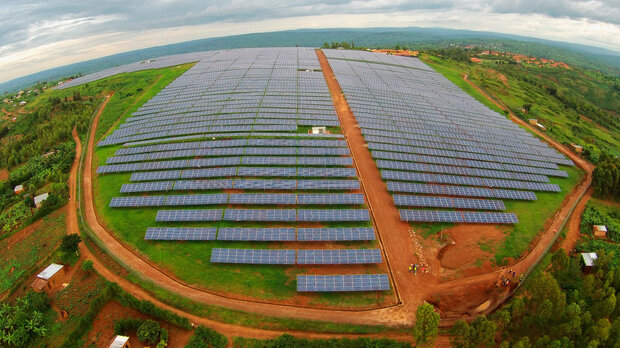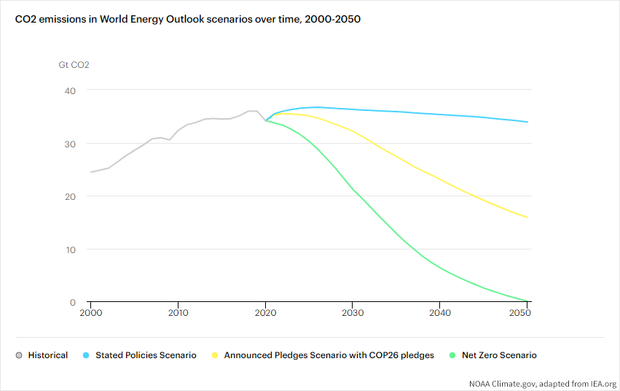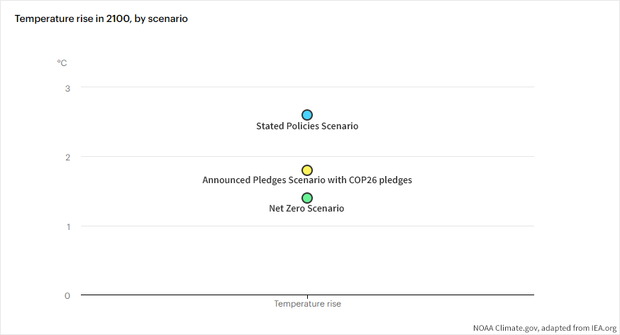What is COP?
I’m seeing climate news stories about “COP27”. What is COP?
COP is an international climate meeting held each year by the United Nations. COP is short for “Conference of the Parties,” meaning those countries who joined—are “party to,” in legal terms—the international treaty called the U.N. Framework Convention on Climate Change (UNFCCC). Parties to the treaty have committed to take voluntary actions to prevent “dangerous anthropogenic [human-caused] interference with the climate system."
Countries take turns hosting an annual meeting at which government representatives report on progress, set intermediate goals, make agreements to share scientific and technological advances of global benefit, and negotiate policy. Last year’s meeting was in Glasgow, Scotland. This year’s meeting, the 27th COP to be held since the UNFCCC treaty was negotiated in 1992, is in Sharm El-Sheikh, Egypt. To see what NOAA is up to at COP this year, see our COP27 page.
Solar field at the Agahozo Shalom Youth Village in Rwanda east of Kigali. It is the first utility-scale, grid-connected, commercial solar field in East Africa. Photo by Sameer Halai, USAID/Power Africa, from the GPA Photo Archive. Used under a Creative Commons license.
What is “dangerous” interference with the climate?
The idea of what is a dangerous amount of global warming is partly a scientific question (what impacts are likely to occur with a given amount of warming) and partly a value judgement (how tolerable those impacts would be). Countries recognized that as warming increased, the risk of impacts that most would consider intolerable would also increase. Based on the science that was available when the UNFCCC treaty was negotiated in 1992, parties agreed that 2 degrees Celsius (3.6 degrees Fahrenheit) above pre-industrial temperatures was ‘an upper limit beyond which the risks of grave damage to ecosystems, and of non-linear responses, are expected to increase rapidly.’
What is the Paris Agreement?
Three decades have passed since the original UNFCCC treaty was developed. Research over that time shows that for some countries and vulnerable ecosystems, the risk of grave damage rapidly increases with less than 2 degrees Celsius (3.6 degrees Fahrenheit) of warming. To account for this, most of the parties to the original UNFCCC treaty signed on to the Paris Agreement in 2015, which obligated countries to develop additional voluntary reductions in greenhouse gas emissions that would limit global warming to well below 2 degrees Celsius (3.6 degrees F), and preferably to no more than 1.5 Celsius (2.7 degrees Fahrenheit).
Following extreme heat stress in 2017, bleached coral at Australia's Great Barrier Reef appear bone white compared to remaining healthy coral, which are golden brown and purple. Photo by Mia Hoogenboom, for ARC Centre of Excellence for Coral Reef Studies.
How do these climate treaties work?
The parties agree to specific goals for limiting human emissions of greenhouse gases (including carbon dioxide, methane, nitrous oxide, and halogen-containing gases like CFCs) to a specific amount by a given year in the future. Countries participating in the treaty develop their own voluntary pledges—known as Nationally Determined Contributions—to meet the agreed-on targets. Countries are free to develop a mixture of policies that is most economical or advantageous for them. They must report on their successes or failures to meet their voluntary targets at the annual COP meetings.
Where do we stand heading into COP27?
Climate simulations show that to limit warming to 1.5°C, with no overshoot, global carbon dioxide emissions from human sources must decline by about 45%
from 2010 levels by 2030, and reach net zero human emissions around 2050. To limit global warming to below 2°C, models indicate we need to reduce carbon dioxide emissions by about 25% over 2010 levels by 2030 and reach net zero around 2070.
According to the International Energy Administration’s 2022 World Energy Outlook (see Figure 3.2 on page 127), if all the pledges that individual countries have announced so far are implemented fully and on time, Earth’s temperature is likely to rise by about 1.8 degrees Celsius (3.2 degrees Fahrenheit) by 2100. That’s under the “dangerous” 2 degrees Celsius threshold, and it keeps the goal of 1.5 degrees Celsius within reach.
Global annual carbon dioxide emissions since 2000 (gray line) and possible future pathways. The blue line shows projected future emissions based on only on countries' stated policies (in place or in development) to reduce emissions. The yellow line shows emissions based on what COP countries pledged to do following COP26 in 2021. The green line shows how quickly emissions will need to drop for the global economy to reach net zero carbon dioxide emissions by 2050. NOAA Climate.gov graphic, derived from original by the International Energy Administration from their 2022 World Energy Outlook. Climate.gov is solely liable and responsible for this derived work. Used under a Creative Commons license.
On the other hand, when the International Energy Administration considered only the policies that are already in place or under development, they projected that warming will likely reach about 2.3 degrees Celsius (4.1 degrees Fahrenheit) by 2100. The difference means that there is a gap between what countries have pledged and what they have been able to put into practice at this point.
Projected temperature increase by 2100 compared to pre-industrial based on different future greenhouse gas pathways. If carbon dioxide emissions peak this decade and reach net zero by 2050, warming will likely be limited to the green dot: about 1.5 degrees Celsius (2.7 degrees Fahrenheit). If all pledges made by countries at COP26 last year are implemented in full and on time, warming will likely be around the yellow dot: 1.8 degrees C (3.2 F). If only policies in place or under development in 2021 wind up being implemented, (blue dot) warming will likely be more than 2.5 C (more than 4.5 F). NOAA Climate.gov graphic, derived from original by the International Energy Administration from their 2022 World Energy Outlook. Climate.gov is solely liable and responsible for this derived work. Used under a Creative Commons license.
What pledges has the United States made as part of the Paris Agreement?
To learn more about the current Administration’s climate strategies, policies, and opportunities, visit the White House Climate Task Force website.



